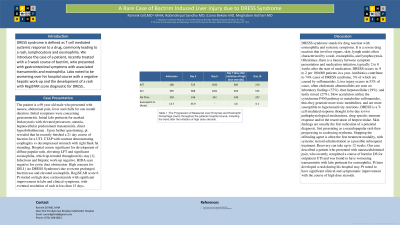Tuesday Poster Session
Category: Liver
P4016 - A Rare Case of Bactrim-Induced Liver Injury Due to DRESS Syndrome
Tuesday, October 24, 2023
10:30 AM - 4:00 PM PT
Location: Exhibit Hall

Has Audio

Ramnik Gill, MD, MS
New York Presbyterian Brooklyn Methodist Hospital
Brooklyn, NY
Presenting Author(s)
Ramnik K. Gill, MD, MS1, Ezana Bekele, MD1, Robinderpal Sandhu, MD2, Meghaben Kothari, MD1
1New York Presbyterian Brooklyn Methodist, Brooklyn, NY; 2Mount Sinai Morningside-West, New York, NY
Introduction: DRESS syndrome is a systemic response to a drug, commonly leading to a rash, lymphocytosis and eosinophilia. We introduce the case of a patient, treated with a prolonged course of bactrim, who presented with GI symptoms with associated transaminitis and eosinophilia with a negative hepatic work-up and the development of a rash with RegiSTAR score diagnostic for DRESS.
Case Description/Methods: The patient is a male who presented with nausea, abdominal pain, fever for one month, concerning for gastroenteritis. Initial labs pertinent for leukocytosis with elevated precursors, anemia, hepatocellular predominant transaminitis, direct hyperbilirubinemia . Upon further questioning, pt revealed that he recently finished a 21 day course of bactrim for a UTI. CTAP with no acute findings. Hospital course significant for development of diffuse papular rash, rising LFT and eosinophilia, which up-trended throughout his stay [1]. Infectious and Hepatic work-up negative. HIDA scan negative for cystic duct obstruction. High concern for DILI (iso DRESS Syndrome) due to recent prolonged bactrim use and elevated eosinophils. RegiSCAR score 6. Pt started on high dose corticosteroids with significant improvement in labs and clinical symptoms, with eventual resolution of rash in less than 15 days.
Discussion: DRESS syndrome is a severe drug reaction that involves organs, skin, lymph nodes often characterized by a rash, eosinophilia, and lymphocytosis. Oftentimes, there is a latency between symptom presentation and medication initiation, typically 2-8 weeks after the start of medication. DRESS occurs in .9 to 2 per 100,000 patients in a year. Antibiotics contribute to 74% cases of DRESS syndrome, 3% of which are caused by sulfonamides. Liver injury occurs in 53% of cases, often cholestatic abnormalities are seen (37%), then hepatocellular (19%), and lastly mixed. Skin findings are usually the first indication of a potential diagnosis, presenting as a maculopapular rash then progressing to coalescing erythema. Stopping the offending agent is often the first treatment modality, with systemic steroid administration as a subsequent treatment. Recovery can take up to 12 weeks. Our case described a patient who presented with nausea/abdominal pain, who recently completed a course of bactrim DS for a UTI and was found to have worsening transaminitis with labs pertinent for eosinophilia and late onset development of rash. Pt noted to have significant clinical and symptomatic improvement with the course of high dose steroids.
Disclosures:
Ramnik K. Gill, MD, MS1, Ezana Bekele, MD1, Robinderpal Sandhu, MD2, Meghaben Kothari, MD1. P4016 - A Rare Case of Bactrim-Induced Liver Injury Due to DRESS Syndrome, ACG 2023 Annual Scientific Meeting Abstracts. Vancouver, BC, Canada: American College of Gastroenterology.
1New York Presbyterian Brooklyn Methodist, Brooklyn, NY; 2Mount Sinai Morningside-West, New York, NY
Introduction: DRESS syndrome is a systemic response to a drug, commonly leading to a rash, lymphocytosis and eosinophilia. We introduce the case of a patient, treated with a prolonged course of bactrim, who presented with GI symptoms with associated transaminitis and eosinophilia with a negative hepatic work-up and the development of a rash with RegiSTAR score diagnostic for DRESS.
Case Description/Methods: The patient is a male who presented with nausea, abdominal pain, fever for one month, concerning for gastroenteritis. Initial labs pertinent for leukocytosis with elevated precursors, anemia, hepatocellular predominant transaminitis, direct hyperbilirubinemia . Upon further questioning, pt revealed that he recently finished a 21 day course of bactrim for a UTI. CTAP with no acute findings. Hospital course significant for development of diffuse papular rash, rising LFT and eosinophilia, which up-trended throughout his stay [1]. Infectious and Hepatic work-up negative. HIDA scan negative for cystic duct obstruction. High concern for DILI (iso DRESS Syndrome) due to recent prolonged bactrim use and elevated eosinophils. RegiSCAR score 6. Pt started on high dose corticosteroids with significant improvement in labs and clinical symptoms, with eventual resolution of rash in less than 15 days.
Discussion: DRESS syndrome is a severe drug reaction that involves organs, skin, lymph nodes often characterized by a rash, eosinophilia, and lymphocytosis. Oftentimes, there is a latency between symptom presentation and medication initiation, typically 2-8 weeks after the start of medication. DRESS occurs in .9 to 2 per 100,000 patients in a year. Antibiotics contribute to 74% cases of DRESS syndrome, 3% of which are caused by sulfonamides. Liver injury occurs in 53% of cases, often cholestatic abnormalities are seen (37%), then hepatocellular (19%), and lastly mixed. Skin findings are usually the first indication of a potential diagnosis, presenting as a maculopapular rash then progressing to coalescing erythema. Stopping the offending agent is often the first treatment modality, with systemic steroid administration as a subsequent treatment. Recovery can take up to 12 weeks. Our case described a patient who presented with nausea/abdominal pain, who recently completed a course of bactrim DS for a UTI and was found to have worsening transaminitis with labs pertinent for eosinophilia and late onset development of rash. Pt noted to have significant clinical and symptomatic improvement with the course of high dose steroids.
Disclosures:
Ramnik Gill indicated no relevant financial relationships.
Ezana Bekele indicated no relevant financial relationships.
Robinderpal Sandhu indicated no relevant financial relationships.
Meghaben Kothari indicated no relevant financial relationships.
Ramnik K. Gill, MD, MS1, Ezana Bekele, MD1, Robinderpal Sandhu, MD2, Meghaben Kothari, MD1. P4016 - A Rare Case of Bactrim-Induced Liver Injury Due to DRESS Syndrome, ACG 2023 Annual Scientific Meeting Abstracts. Vancouver, BC, Canada: American College of Gastroenterology.
